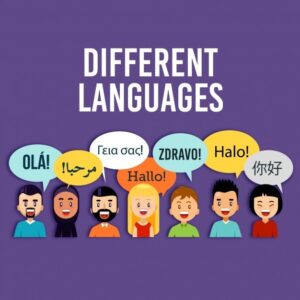Languages serve as more than mere tools for communication; they embody culture, history, and identity. However, many languages have become silent over time, resulting in a complex landscape of dead languages that face the risk of being forgotten permanently.
This article examines the concept of dead languages, the factors contributing to their extinction, and the challenges associated with their revitalization. It also emphasizes successful revival initiatives and their influence on cultural heritage, historical understanding, and community revitalization.
This exploration invites readers to delve into the compelling journey of revitalizing these ancient languages.
What Are Dead Languages?
.jpg_00.jpeg)
Dead languages are defined as those that no longer possess any native speakers and are not actively employed in communication. They represent a significant aspect of linguistic diversity and cultural heritage, playing a crucial role in language preservation and language documentation efforts.
Notable examples include Latin, Ancient Greek, and numerous indigenous languages that have ceased to be used due to various socio-cultural factors. Understanding dead languages is essential for language preservation initiatives and the documentation of cultural practices, as these languages frequently contain valuable historical and anthropological insights.
Why Do Languages Become Extinct?
Languages face extinction due to a complex interplay of factors, including natural causes, cultural shifts, and political dynamics. These elements contribute to the gradual decline of community involvement, loss of language transmission, and the erosion of language rights, resulting in endangered languages.
Economic pressures, globalization, and the dominance of major languages often marginalize smaller languages, leading to their endangerment and, ultimately, extinction. The loss of these languages not only diminishes linguistic diversity but also undermines cultural identity, cultural preservation, and heritage.
1. Natural Causes
Natural causes of language extinction frequently arise from environmental changes that can lead to population shifts, adversely affecting the transmission of languages within communities and threatening their survival. For instance, natural disasters, climate change, and habitat destruction can displace speakers and disrupt the continuity of both oral traditions and written records, ultimately resulting in the decline of a language.
The implications of such disruptions are significant. When a community is compelled to relocate due to catastrophic events such as hurricanes or droughts, the new environment may not support the cultural practices that are essential for sustaining their language.
For example, indigenous languages that are closely tied to specific landscapes, such as those of Native American tribes, can lose their relevance and speakers when those landscapes are altered or destroyed. This loss not only undermines linguistic diversity but also diminishes community resilience, as a shared language is fundamental to cultural identity and cohesion.
Consequently, addressing the challenges presented by natural causes is crucial for preserving these unique languages and promoting the well-being of the communities affected.
2. Cultural and Political Factors
Cultural and political factors play a substantial role in language extinction, as language policies frequently prioritize dominant languages to the detriment of minority languages, thereby undermining cultural identity and heritage.
Political unrest, colonization, and globalization can foster social stigmas against local languages, leading speakers to abandon their native tongues in favor of the dominant culture, which ultimately threatens linguistic diversity.
An illustrative example can be found in the case of the Welsh language in the United Kingdom. Here, renewed activism has resulted in governmental support and education policies that promote the use of Welsh in schools and public life. This initiative demonstrates the critical importance of policy in revitalizing endangered languages and underscores how dedicated advocacy groups can effect meaningful change.
In contrast, regions characterized by oppressive regimes, such as certain areas in Africa and Latin America, often witness the marginalization of indigenous languages, resulting in a significant decline in the number of speakers.
These contrasting scenarios highlight the profound influence of socio-political environments on language survival, emphasizing the ongoing struggle for linguistic rights worldwide.
What Are the Challenges of Reviving Dead Languages?
Reviving dead languages poses numerous challenges, including the absence of native speakers, limited resources, and the complexities involved in reconstructing the language’s grammar, phonetics, and vocabulary. Language revival requires comprehensive language revitalization frameworks and strategies to overcome these obstacles.
These obstacles can impede language revitalization efforts and necessitate substantial community engagement as well as collaboration among educational programs, language documentation initiatives, and linguistic research. Community-led initiatives and cultural revival projects are crucial for the successful revival of these languages.
Effective strategies typically incorporate the use of technology, such as language applications and online platforms, to engage new learners and develop accessible resources. Online courses and language technology are key components in providing innovative language education and supporting language enthusiasts.
1. Lack of Native Speakers
The absence of native speakers presents a significant obstacle to the revitalization of dead languages, as important linguistic nuances, oral traditions, and cultural contexts are frequently lost without a living community to sustain them. This challenge highlights the need for robust community engagement and innovative language teaching methodologies, such as language immersion programs, language classes, and language festivals, to cultivate new speakers and foster connections to the language.
These strategies can effectively bridge generational gaps and stimulate interest within younger communities. By creating immersive experiences that honor the language’s history and cultural significance, individuals can gain a deeper appreciation for its value. Youth involvement and intergenerational transmission are vital to sustaining the momentum of language learning and linguistic revival.
Collaborations among local organizations, educational institutions, and cultural entities can result in dynamic programming, including interactive workshops, language workshops, and storytelling sessions that not only teach the language but also link participants to its origins. Such initiatives can reshape perceptions surrounding these languages, promote community ownership, and ultimately contribute to their sustainability. Mentoring programs and public outreach enhance these efforts by fostering cultural exchange and community engagement.
2. Limited Resources
.jpg_01.jpeg)
Limited resources present a significant challenge to the revival of dead languages, as inadequate funding for language projects and a lack of access to language resources and grants can obstruct educational programs and community initiatives. Securing funding initiatives is essential to support language education and revitalization initiatives.
The incorporation of technology in language revitalization efforts, such as language applications and online courses, can help alleviate these resource constraints by providing accessible tools for learners and language advocates. Technology-driven educational outreach and digital humanities projects also enhance cultural sustainability and linguistic engagement.
Securing stable funding is essential not only for immediate projects but also for ensuring long-term sustainability. Communities striving to restore their linguistic heritage, or heritage languages, often encounter the formidable challenge of competing for diminishing resources. Government support and policy frameworks can play a vital role in providing stable financial backing.
By utilizing technology, including social media platforms and digital storytelling tools, advocates can attract attention and garner support, thereby emphasizing the cultural significance of these languages. Online crowdfunding campaigns and collaborations with educational institutions can further improve visibility and increase the resources available for revitalization efforts. Language networks and cultural projects facilitated through these mediums promote cross-cultural communication and language initiatives.
This comprehensive approach ensures that preservation initiatives can flourish despite the challenges posed by limited funding and accessibility.
3. Difficulty in Reconstructing the Language
The challenge of reconstructing dead languages arises from gaps in historical data, which complicates efforts to ascertain accurate phonetics, grammar, and vocabulary. This process necessitates extensive research in historical linguistics and often depends on written documentation, historical records, and oral traditions, which may be incomplete. Linguistic anthropology provides additional insights into the cultural practices and identity preservation associated with these languages.
Collaborative projects and linguistic tools that facilitate data analysis and documentation can significantly enhance the efforts to reconstruct these languages. Natural language processing and linguistic research are increasingly important in advancing these methodologies.
Linguists are confronted with the formidable task of piecing together remnants of communication from a fragmented past, where each discovery can result in both significant breakthroughs and unforeseen setbacks. By employing methodologies such as comparative linguistics, phonetic inventories, and syntactic analysis, researchers endeavor to construct a coherent understanding of a language’s structure. Language assessments and teaching materials developed through these studies support educational programs and language maintenance efforts.
The absence of consensus on certain data points can further complicate this undertaking, underscoring the inherent variability in language use over time. Language revitalization movements often face challenges in achieving agreement on linguistic heritage and ethnolinguistics, requiring ongoing dialogue and cultural projects.
Collaboration is essential, as integrating expertise from diverse fields—such as archaeology, anthropology, and modern technology—can increase the likelihood of successful revitalization. Language conferences and cultural exchange programs foster interdisciplinary approaches, enhancing the social impact of language activism and cultural revival.
Ultimately, these multifaceted efforts not only seek to revive forgotten languages but also contribute to a deeper understanding of human history and culture. They demonstrate the social impact of language revival and the importance of identity preservation.
Successful Projects in Reviving Dead Languages
Successful projects aimed at reviving dead languages frequently serve as exemplary models for language revitalization initiatives. They demonstrate how community involvement, innovative educational programs, bilingual education, and effective language policy can significantly contribute to the preservation of cultural heritage. Revival success stories inspire further language awareness and activism.
These projects underscore the importance of collaboration among language advocates, governmental support, and grassroots movements in fostering linguistic revival and maintaining community engagement. Language ambassadors and diaspora communities play critical roles in supporting these initiatives and facilitating cultural sustainability and intergenerational transmission.
1. The Revival of Hebrew: A Case Study in Language Revitalization
The revival of Hebrew serves as a significant example of language revitalization, demonstrating the successful reinvigoration of a previously dead language through community engagement, educational initiatives, and an increased sense of cultural identity among its speakers. This transformation exemplifies how language activism, sociolinguistics, and intentional language policy can cultivate a dynamic linguistic community.
Building on historical efforts that began in the late 19th century, the movement gained substantial momentum in the early 20th century, particularly through the advocacy of figures such as Eliezer Ben-Yehuda. Their endeavors were motivated by a collective aspiration to reconnect with ancestral roots and establish a distinct national identity, particularly highlighting the importance of heritage languages and cultural heritage, especially in the face of considerable challenges confronting the Jewish population.
This resurgence not only transformed Hebrew into a modern spoken language but also played a vital role in uniting diverse communities around shared narratives and traditions, thereby enhancing social cohesion and fostering a sense of belonging. Language revival and community-led initiatives were key to these efforts.
Educational strategies, including immersion courses and bilingual programs, further ensured that new generations would maintain both proficiency and pride in their linguistic heritage.
2. The Revival of Cornish
The revival of the Cornish language demonstrates how cultural heritage and community engagement can effectively drive language revitalization initiatives. Programs such as language festivals, bilingual education, and educational workshops play a critical role in fostering a vibrant language community.
These activities not only promote the use of the language but also strengthen connections among speakers and learners, ensuring successful projects and cultural revival.
Furthermore, the incorporation of storytelling sessions, oral traditions, and local art exhibitions enriched by the Cornish language enhances the cultural experience for all participants. Various organizations have acknowledged the significance of collaboration among schools, local businesses, and cultural institutions to improve the accessibility and visibility of the Cornish language.
By integrating the language into daily life and community events, residents celebrate their heritage while inspiring future generations to embrace their linguistic roots and engage in language transmission.
These engaging activities contribute to a stronger sense of identity, rendering the revival of Cornish not merely a project, but a collective journey aimed at preserving a cherished legacy.
3. The Revival of Hawaiian
The revival of the Hawaiian language has gained significant momentum through immersive educational programs, language education, and community-driven initiatives that prioritize language learning and cultural sustainability. This effort underscores the vital role of language in articulating cultural identity and addressing language loss.
The revitalization initiative emphasizes the effectiveness of language immersion and storytelling in cultivating a new generation of speakers, supporting intergenerational transmission.
By incorporating Hawaiian into school curricula and community activities, individuals across various age groups are afforded numerous opportunities to engage with their heritage. Community workshops, language camps, youth involvement, and local events not only impart foundational knowledge of the Hawaiian language but also introduce participants to traditional practices, songs, and oral histories that enhance their understanding of the language.
Collaborative partnerships between educational institutions and cultural organizations are crucial for ensuring that these programs remain relevant and accessible, thereby fostering a strong sense of community. This cooperative approach guarantees that revitalization efforts are grounded in authentic cultural expression, promoting a sense of pride among both speakers and learners, and contributing to cultural exchange and revival success stories.
Impact of Reviving Dead Languages
.jpg_10.jpeg)
The revival of dead languages has far-reaching implications that extend beyond simple linguistic restoration. It plays a crucial role in the preservation of cultural heritage, promotes community engagement, and enhances linguistic diversity through language revival.
Successful outcomes in language revitalization offer significant insights into the intricate relationships between language, culture, and identity. This underscores the vital importance of preserving linguistic traditions for the benefit of future generations and the role of multilingualism in sustaining linguistic diversity.
1. Preservation of Cultural Heritage
The preservation of cultural heritage is intricately linked to the revival of endangered languages, as these languages encapsulate unique storytelling traditions, local dialects, and cultural practices that significantly contribute to a community’s identity, thereby also preserving indigenous languages.
The revival of these languages not only safeguards linguistic heritage but also enhances the understanding of the cultural narratives associated with them, playing a crucial role in identity preservation.
This revitalization is critical in reinforcing communal bonds, enabling individuals to reconnect with their ancestors and the wisdom embedded in their narratives. Language functions as a vessel of history, conveying values, beliefs, and experiences that shape a community’s worldview.
As individuals reclaim their linguistic roots, they often engage in broader cultural expressions, such as music and art, which further fortify their heritage and contribute to cultural preservation.
Ultimately, the act of reviving a language transcends mere words; it represents a collective journey toward self-identity, resilience, and a deeper appreciation of one’s cultural landscape, contributing to linguistic revival.
2. Improved Understanding of History
Reviving dead languages enhances our understanding of history by providing valuable insights into cultural practices, societal structures, and interactions as documented in written records. Linguistic studies, historical linguistics, and language documentation are integral to reconstructing the past and elucidating the evolution of languages over time.
These efforts not only deepen our comprehension of ancient civilizations but also illuminate the connections and exchanges that contributed to their identities. By meticulously analyzing phonetics, syntax, and semantics within the context of their distinct historical environments, scholars can uncover critical details that enrich the broader narrative of human history, contributing to linguistic research and ethnolinguistics.
Such initiatives preserve unique perspectives on human experiences, enabling contemporary societies to draw lessons from their ancestors. The careful documentation of these languages through various mediums, such as written documentation, fosters a greater appreciation for cultural heritage, underscoring the notion that language is an essential thread in the fabric of historical understanding.
3. Revitalization of Indigenous Communities
The revitalization of indigenous communities is often significantly linked to the revival of their languages, as restoring linguistic practices can reinvigorate cultural identity and give the power to communities to assert their language rights. Engaging communities in language revitalization initiatives fosters pride and strengthens connections to their heritage, thereby enhancing social cohesion among speakers and supporting language maintenance.
This process not only nurtures an individual’s sense of belonging but also facilitates intergenerational knowledge transmission, enabling younger members to learn from their elders through mentoring programs. Language revival serves as a means for communities to articulate their unique worldviews, which are frequently rooted in rich historical narratives and local ecosystems.
As communities embrace their linguistic heritage, they assert their rights on a broader scale, advocating for the recognition and inclusion of their languages within educational systems and public life. Such initiatives not only contribute to the preservation of languages at risk of extinction through language resources and language documentation projects, but also foster a vibrant social landscape where cultural diversity is celebrated and respected.
4. Contribution to Linguistic Diversity
Reviving dead languages plays a crucial role in enhancing linguistic diversity, thereby enriching the global tapestry of languages and promoting multilingualism within communities. Efforts directed toward language preservation not only protect unique linguistic features but also foster community engagement in the maintenance of diverse linguistic practices, facilitated by language networks and language ambassadors.
Such initiatives often evoke a sense of pride among community members as they reconnect with their heritage and cultural identity. Participation in language revival projects, including language classes and online platforms, facilitates the transmission of knowledge to younger generations, ensuring that these languages do not fade into obscurity.
This engagement enhances the cognitive and social abilities of individuals as they interact with multiple languages, creating an enriched environment that celebrates the complexities of communication and supports cross-cultural communication.
Ultimately, the embrace of language revival not only strengthens community bonds but also nurtures a vibrant society where linguistic diversity flourishes, reflecting the collective human experience and the importance of language initiatives.
How Can Individuals and Organizations Support Language Revitalization Efforts?
Individuals and organizations can significantly contribute to language revitalization efforts through active community involvement, advocacy for funding for language-related projects, and the promotion of educational programs that facilitate language learning, including community resources and language revitalization frameworks.
Language activism serves to raise awareness regarding the importance of preserving linguistic heritage and can motivate action toward revitalization initiatives, supporting grassroots movements and cultural projects.
Frequently Asked Questions
.jpg_11.jpeg)
1. What is the importance of reviving dead languages?
Reviving dead languages is important because it helps preserve cultural heritage, aids in language documentation, and allows for a deeper understanding of our past. It also promotes linguistic diversity and can have a positive impact on local communities, fostering social impact and cultural exchange.
2. How do successful projects for reviving dead languages impact communities?
Successful projects for reviving dead languages can have a significant impact on communities by promoting cultural pride, preserving traditional knowledge, and strengthening community identity. These efforts are often seen as crucial aspects of language preservation and cultural heritage, contributing to linguistic diversity and community engagement.
3. Can anyone participate in reviving a dead language?
Yes, anyone can participate in reviving a dead language. While it may require some level of language proficiency and cultural understanding, there are often opportunities for community members, linguists, and volunteers to be involved in preservation efforts. Community-led initiatives, language education, and language workshops are popular methods to enhance language learning and involvement.
4. Are there any challenges in reviving dead languages?
Yes, there can be several challenges in reviving dead languages, such as a lack of language resources, limited speakers or material to work with, and potential conflicts between traditional and modern usage of the language. Addressing these challenges often involves language policy, funding initiatives, and the development of educational programs.
5. How do successful projects for reviving dead languages impact future generations?
Successful projects for reviving dead languages can have a lasting impact on future generations by ensuring the language and cultural traditions are passed down and not lost, providing a sense of cultural identity, and promoting multilingualism. These projects often involve language transmission through intergenerational teaching methods and language education.
6. What are some examples of successful projects for reviving dead languages?
Some successful projects for reviving dead languages include language immersion programs, collaboration between linguists and native speakers, and the use of modern technology to document and teach the language. These revitalization strategies often employ language documentation projects and language technology. The revitalization of Hebrew and Hawaiian are notable examples of successful language revival projects that have inspired linguistic revival movements globally.

My name is Bruno, I have been a writer for 5 years and I work with website creation. My goal is to provide true information to readers. In fact, on this site I write about cultures and traditions, which I have been passionate about since childhood.




